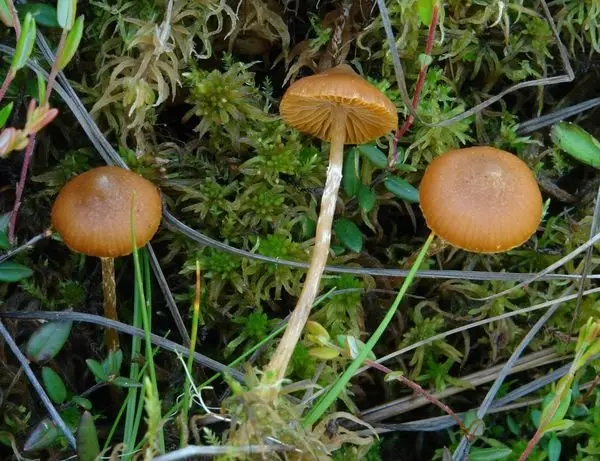Galerina Bolotnaya (Galerina paludosa)
- Division: Basidiomycota (Basidiomycetes)
- Subdivision: Agaricomycotina (Agaricomycetes)
- Class: Agaricomycetes (Agaricomycetes)
- Subclass: Agaricomycetidae (Agaricomycetes)
- Order: Agaricales (Agaric or Lamellar)
- Family: Hymenogastraceae (Hymenogaster)
- Genus: Galerina (Galerina)
- Type: Galerina paludosa (Galerina Bolotnaya)

Author of the photo: Olga Morozova
Hat:
in a young mushroom, the cap has a bell-shaped or convex shape, then, as it matures, it becomes wide-convex prostrate, almost flat. In the central part of the cap, a sharp conspicuous tubercle is preserved. A watery, smooth cap at a young age is covered with whitish fibers, the remains of a destroyed bedspread. The cap is XNUMX to XNUMX inches in diameter. The surface of the cap has a honey-yellow or yellowish-brown color, sometimes with whitish fibers along the edges. With age, the color of the cap fades and becomes dark yellow.
Leg:
filiform long leg, eight to thirteen centimeters high. The leg is very thin, flaky, powdery, light yellow in color. In the lower part of the leg, as a rule, there are whitish zones, the remains of a cobweb cover. At the top of the leg is a ring painted white.
Pulp:
brittle, thin, of the same color as the surface of the cap. The pulp does not have a pronounced taste and has a light pleasant taste.
Hymenophore:
the lamellar hymenophore consists of frequent and rather rare plates adhering to the base of the stem or descending along it with a tooth. In young mushrooms, the plates are colored light brown, as the spores mature, the plates darken and acquire an ocher-brown color with lighter edges. The plates are yellowish-brown, notched. Spore powder: ocher color.
Disputes:
broad ovoid, with sprouting pores. Cheilocystidia: spindle-shaped, numerous. Basidia: composed of four spores. Pleurocystidia are absent. The cap is also missing. Hyphae with clamps up to 15 µm thick.
Galerina Bolotnaya, found in forests of various types, mainly in wetlands, among sphagnum. Bryophil. This species is quite widespread in North America and Europe. Prefers mossy wetlands. Occurs from late June to late September. It grows in small groups, but more often singly.
Swamp Galerina is not eaten, it is considered poisonous a mushroom
Reminiscent of Galerina tibiicystis, which is distinguished by the shape of the cheilocystids, spores, and the absence of a spathe.









